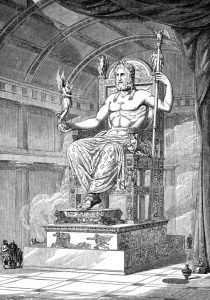 Ask anyone who knows me, and they’ll tell you that I’m definitely not a reactionary type. I consider myself to be progressive about most things. But in some regards, I’m an unapologetic originalist. I almost always prefer the first recording of a song to the cover version, the original version of a movie to the remake, authentic ethnic food to an anglicized, family restaurant dish, and charcoal over propane. Knowing that, it should come as no surprise that I’m not entirely sold on the whole theory of progress idea. Looking at the ancient world, one has to wonder whether we’ve really come as far as we like to think we have. Sure, modern medicine with penicillin and vaccinations is great, and it’s tough to imagine life without the Internet anymore even though it’s been around for less than half of my lifetime.
Ask anyone who knows me, and they’ll tell you that I’m definitely not a reactionary type. I consider myself to be progressive about most things. But in some regards, I’m an unapologetic originalist. I almost always prefer the first recording of a song to the cover version, the original version of a movie to the remake, authentic ethnic food to an anglicized, family restaurant dish, and charcoal over propane. Knowing that, it should come as no surprise that I’m not entirely sold on the whole theory of progress idea. Looking at the ancient world, one has to wonder whether we’ve really come as far as we like to think we have. Sure, modern medicine with penicillin and vaccinations is great, and it’s tough to imagine life without the Internet anymore even though it’s been around for less than half of my lifetime.
But ask yourself, what does the 21st Century offer to rival the seven wonders of the ancient world?
The American Society of Civil Engineers has a list of modern engineering wonders and, make no mistake, it’s impressive. Yet I can’t escape the nagging feeling that our steel mills, steam-driven excavators, tower cranes, and computer-aided structural analysis constitute cheating on some level.
The question is not whether we could re-master the 3rd Century B.C. technology that built the Colossus of Rhodes the first time around. I’m sure we could. The question is whether we’d have the stomach for it. Could we muster the political and economic fortitude to spend 40 years piling behemoth stones with our backs and our hands until they made a pyramid that would last 5,000 years?
To my mind, at least, the ancient world’s monuments of bronze and stone have a magnificence that can’t be matched by modern constructions of steel and concrete, no matter how high we pile them up. Maybe that’s because a part of me can still imagine gazing at the Temple of Artemis or the Statue of Zeus, with little knowledge of machines beyond the lever and the ramp, and wondering with amazement, “How did they do it?”
We humans are the only creatures on this planet with the drive to build monuments, and that drive seems to be universal among us. Some element in our nature pushes us to make things that are taller, wider, more permanent, and more beautiful than anything has ever been before. Is it because we just can’t get enough of those opposable thumbs? To impress the hairy monkeys with our big brains? To reassure ourselves that we are masters of the universe? Or do we build monuments because we are the only creatures who foresee our own deaths?
One thing is certain. If elves, dwarves, halflings, dragonborn, giants, Klingons, droyne, and badders share that spark of essential humanness, then they, too, will build monuments. With the aid of magic, mutations, and antigravity tech, their marvels might well put ours to shame.
What’s vital in your fictional universe is that the sense of wonder isn’t made humdrum by magic and technology. If the Burj Khalifa seems less impressive to you than the Lighthouse of Alexandria, then you know what I’m talking about.
Monuments inspire awe because of what they convey about the human spirit. They measure the limit of what humans can achieve. If magic or technology reduces the question of what’s possible to a question of return-on-investment, then the impossible task becomes finding a way to stir feelings of true wonder in readers and players.


Could we muster the political and economic fortitude to spend 40 years piling behemoth stones with our backs and our hands until they made a pyramid that would last 5,000 years?
I think it’s worth noting that the “we” you’re talking about was generally a succession of generation after generation of thousands of slaves. I’m pretty sure the pharaohs didn’t spend their summer afternoons piling stones at Giza.
In that sense, ancient monuments can be seen as having a kind of sinister grandeur. Like the North American railroads, knowing what we know about the fates of the men who built them.
From what I’ve seen the pyramids were built using a communal effort by the whole country, not just slaves. You’re basically building the eternal resting place of your God-king – you wouldn’t leave that up to slaves, although I’m sure they were involved at some level. Villages would send men to work on the pyramids for a couple of years. These men were paid in food and lodging. The whole enterprise brought the country together: workers would return to their villages having made friends from elsewhere, would be speaking and writing a common language and using a common set of weights and measures and spending common currency.
I don’t think of the pyramids as sinister at all! When completed they were finished with polished limestone and topped with a golden capstone – you probably wouldn’t be able to look directly at them in the sunlight. The Egyptian people of that time would look at them and rest assured that their pharaoh was ‘up there’ looking out for them.
Vaelorn is correct. The Egyptian government made use of slaves, especially during the reigns of conquest-minded pharoahs like Thutmose II and Rameses III (IIRC), but the pyramids were built by free men. http://harvardmagazine.com/2003/07/who-built-the-pyramids-html I’m sure they had days when they wished for some other job, but I have days like that, too.
You made me think of Ted Chiang’s “Tower of Babylon.” http://en.wikipedia.org/wiki/Tower_of_Babylon_(story)
I think in the early part of the 20th century there were efforts to match the ancient world. Look at the craftsmanship of the Chrysler Building, the Empire State Building, the St. Louis Arch, or even Mount Rushmore. These are all magnificent structures right here in our Country and all on a scale that equals or exceeds many of the ancient’s wonders.
Fitz, if that was the goal, then the builders, designers and engineers utterly failed. The Empire State Building is nowhere near as impressive as the Pyramids. It’s not even in the same league. There is absolutely no mystery to it, no grace, no wonder and no imagination. 5 thousand years from now it will not even be there. No, the author is quite correct in his assessments. Our civilisation is deluded; we have been infected with the Roman arrogance that says, ‘We are superior! Everyone else is a barbarian!’ when in actual fact, nothing could be further than the truth. We cannot even live our lives in harmony with the environment around us, something many ancient cultures learned to do because it is vital if we are to survive – and for the myriad species of life that share that same environment with us.
Very few civilizations, including most Native American ones, truly lived in harmony with their environment when they had the means to exploit it. Protecting the environment is the hard road, not the obvious one.
Moving on, I agree with Winter’s assessment that our physical monuments are less grand, but our achievements are no less great. The efforts and wealth of millions have gone into putting a man on the moon, to wiping out smallpox and rinderpest, and to sharing our knowledge on an unprecedented scale with projects like Wikipedia. The difference is that we no longer live in a civilization where the cost of labor is comprable with the cost of food, and so the few cannot dictate that the resources of the many will be spent on self-aggrandizing (albeit magnificent) projects. The mass of humanity beginning to claw its equality from the clutches of the elite is well worth the price of some romantic ruins. And I say this as a person who has delved the pyramids, climbed the great wall, and gazed in wonder on the Parthenon. My professional life is the study the past, but I would never say I would trade modernity for it.
We have toilets, after all :)
The greatest marvel of the modern age, to my mind, is the modern city. Modern cities depend on a infrastructures that vastly outsrip anything the ancients had, and as a result are able to accommodate populations that ancient or medieval cities could not ever hope to achieve. To say that our greatest achievments are organisation and infrastructure may not seem as grandiose as the pyramids of egypts, but I don’t consider it any less of an accomplishment. As a result of it, nearly every single person in the wetern world possesses a level of comfort, health, and safety that rivals ancient kings. And to my mind, you have to be a little jaded not to see a city skyline lit up at night as a sight inspiring delight and awe, and we don’t have just one of those, but thousands. Furthermore, this infrastructure allows unprecedented levels of personal freedom. Slavery is abolished in the western world, something that would have been unthinkable in the ancient. Our horizons are not limited to our own town, nation or even continent, but most peopel, if they wish it, (not merely the wealthiest) have the power to make their life anywhere they wish in the world.
“The mass of humanity beginning to claw its equality from the clutches of the elite is well worth the price of some romantic ruins.” What utter tosh. We have all been made slaves to greedy capitalists who ultimately have no morals and whose only real goal is to make as much money as possible… and pay as little tax as they can get away with. They’ll turn the earth over, raze forests, pollute oceans and cause wars and genocide if it will make them more money at the end of it… And somehow that is better than serving king and country? We’ve got it all backwards. Were slaves, through mortgages, through how everything costs money, through rising inflation, through debt, and so on. In the past… water was free! Now our water supplies are locked up by water companies who force us to pay.. to pay to live. It’s not safe to drink rain water any more thanks to the pollution of these greedy masters of our civilisation. Need I go on?
@The Recursion King – It must be sad living in your world.